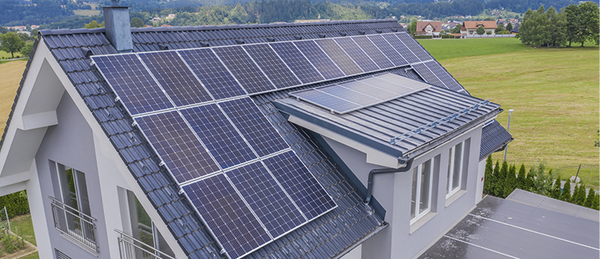The Low Energy Build
Homevalue gives advice on low energy builds v's a more expensive retrofit.
Energy Friendly Design
One of the advantages of a self-build is that you can opt for an energy-friendly design and select the latest energy-efficient systems and technologies without having to resort to a costly energy retrofit. You can then sit back and look forward to years of reduced energy bills and a likely increase in the value of your new home.
The BER is an indication of the energy performance of a dwelling. It is calculated using Dwelling Energy Assessment Procedure (DEAP) which measures the construction material used for the property, ventilation, fuel used to provide general and water heating, thermal storage capacity and external exposure and lighting of the property. The results are expressed in kilowatt-hours (kWh) of primary energy used for space and water heating, ventilation and lighting, per square metre of the building, per year. An estimate of the carbon dioxide emitted, in kilograms of carbon dioxide per square metre of the building per year, is also made.
BER Advice
In Ireland, BER performance bands range from A1, which represents the most efficient level to G, the least efficient grade. An A1 rating is achieved where the primary energy used is between 0 and 25 kWh per square metre per year. A2 and A3 ratings are where the dwelling has a primary energy consumption of 25 up to 50 and of 50 up to 75 kWh per square metre respectively.
In achieving an A rating, energy performance will improve across multiple fronts. BER assesses not only insulation and U-Values (the measure of heat loss through the fabric of the building), but also thermal mass, air tightness, window glazing and size, boiler performance, fuel type, light bulbs, and more. Taken together, small changes in many of these make a big impact.
According to independent studies carried out on behalf of the Irish Concrete Federation, an A rated house shows a cumulative improvement in energy performance of over 50% for over a typical 2005 building regulations dwelling. Improving a building regulation compliant dwelling to an A rating will typically reduce primary energy consumption from around 160 kWh to less than 75 kWh per square metre of building space per year.
Passive Houses
Some measures are more cost-effective than others and most Irish architects experienced in designing energy-efficient homes favour the ‘fabric first’ approach, which is based upon the Passivhaus concept first developed in Germany over thirty years ago. This approach focusses on dramatically reducing energy usage in homes by directing attention to the design and construction elements of the build and making the property as airtight as possible. A central principle of passive house design is to reduce heat loss by heavily insulating the home, creating airtight building envelopes and eliminating thermal bridges.
While a passive house typically costs around 8% to12% more than a conventional house as a result of the upgraded building envelope and mechanical ventilation system, this cost will be amply repaid over the life cycle of the property as a result of reduced energy consumption and virtually non-existent heating bills.
In addition, many passive house advocates contend that a passive house can be built to the same price as a conventional home through rigorous planning and precise execution of construction and site management. In a recent study, Shane Colclough, a Research Fellow at the Centre for Sustainable Technologies at the University of Ulster investigated the costs of building an A1 rated passive house compared to a home built according to minimum compliance under building regulations. The research was based on the case study of Madeira Oaks, a 12-unit scheme in Enniscorthy, Co. Wexford, and the answer was €132 – hardly a decisive difference.
You may not want the added complications and added stress involved in seeking Passivhaus certification but applying the core principals and adopting a ‘fabric first’ approach will deliver several tangible benefits, including excellent indoor air quality, a constant supply of fresh air as well as a reduction in maintenance and running costs and a dramatic reduction in energy consumption and CO² emissions.
By constructing the building fabric so that heat loss is reduced to the bare minimum and internal heat gains are maximised, there is less requirement for conventional heating systems and your energy needs can be met more readily and economically by renewable technologies.
It is important to get your approach right from the beginning and designing a property according to passive house principals requires careful and detailed planning. Many of the measures adopted are relatively inexpensive but will make a significant contribution towards improving your overall BER rating.
AIRTIGHT SELF BUILD
Here are some of the steps to consider to achieve an airtight self-build.
Orientation
Most sites will facilitate the positioning of south-facing windows which can improve efficiency by 4% at minimal cost. Concrete homes of medium thermal mass can benefit particularly well, where the design promotes good passive solar gain. Consider keeping glazing to a minimum on the north-facing elevation of your self-build and focus on insulation instead.
Windows and Doors
Most heat loss occurs through windows and doors so the decisions about the quantity and types included in your design are significant. The U-Value is the standard measure for the insulation properties of a window – the lower the numerical value, the better the insulation.
There have been significant developments in glazing in recent years and wider use of triple glazed units. Due to its increased density, triple glazing can help reduce noise and can regulate solar gain, whilst increasing thermal comfort. However, triple glazing is still approximately 10-15% more expensive than a double-glazed performance window.
Improving the U-Value for windows and external doors from 2.20 to 1.50 with, for example, triple glazing, argon-filled cavity and soft low-E glass (glass coated to minimise the amount of ultraviolet and infrared light that can pass through without compromising the amount of visible light) improves efficiency and is done easily when installing or renewing windows. This will cost around €3,000 but if the budget is tight, the best trade-off between cost and performance may be to opt for highperformance argon or crypton filled double glazing units.
Thermal Mass
A material’s thermal mass is, fundamentally, its ability to absorb and store heat and it is a vital and complementary component of passive solar design. A material that has thermal mass has the capacity to absorb, store and release the sun’s heat energy. Materials with high thermal mass such as brick, concrete, stone or ceramic tiles heat up slowly and then distribute their heat gradually. Their density and levels of conductivity help to keep the internal temperature of a building stable. Materials with thermal mass should ideally be used in the floor or inside walls and located near the southern facing windows to allow the sun to shine directly on them, so they can store and gradually release the sun’s heat energy.
Thermal Bridging in External Fabric
Thermal bridging around openings in the external fabric increases heat loss. Reducing the proportion of thermal bridging in the external fabric from 0.11 to 0.08 will deliver a 3% improvement in energy efficiency. Typical cost: €1000.
Increasing Insulation
One of the best ways to ensure that a new building is going to achieve a high BER score is to use proper thermal insulation. The Sustainable Energy Authority of Ireland (SEAI) estimates that up to 30% of the heat in your home escapes through the walls and another 30% through the roof. Insulating walls, attics and water tanks are common approaches but the importance of floor insulation has also been clearly established in recent years.
Replace the Open Fire
A balanced flue enclosed stove is far more energy-efficient than an open fire. Removing the open fireplace will typically result in an 11% improvement in efficiency. When the enclosed stove is fired by a renewable fuel source, it also reduces net carbon dioxide emissions.
Improve Airtightness and a Pressurisation Test
In the absence of a pressurization test, the Dwelling Energy Assessment Procedure (DEAP) assumes a casual infiltration rate of 0.50 air changes per hour. Effective sealing around components such as windows and external door frames, electrical terminals and drainage pipes will lower rates significantly. A typical test and supervision costs between €500 and €1000 and can achieve improved efficiency calculations of 5%.
Heat and Power
Once you have taken care of the fabric of your self-build, now you can move on to consider how best to heat and power your home in the most energy-efficient manner possible.
Solar Panels: Your self-build may benefit from the use of a solar panel electricity system. These Solar Photovoltaics (PV), capture the sun’s energy using photovoltaic cells and they do not require direct sunlight to work. This means energy can still be generated on cloudy days which can be used to run everyday appliances and lighting.
Heat Recovery Ventilation Systems: Where the dwelling has a high level of airtightness, contemporary whole building heat recovery ventilation systems deliver up to a 9% increase in energy efficiency. Choose a system that requires only minimal energy to operate fans.
Solar Hot Water Heating System: Solar water heaters will deliver hot water all year round, but can be particularly advantageous in summer, to replace electricity (which is assumed in DEAP to be the primary heat source).
Ground Source Heat Pump: If a renewable fuel source is not used, geothermal heating with a heat pump along with under-floor heating will significantly improve energy efficiency.
Insulate Primary Circuit Pipework: Insulating the primary circuit pipework between boiler and cylinder will typically deliver a 1% improvement in energy efficiency.
Hot Water Cylinder: Increasing the normal 35mm of cylinder insulating foam to 60mm will typically deliver a 1% improvement in energy efficiency.
Install a Wood Pellet Boiler: The efficiency improvement may be slight, but carbon dioxide emissions will be reduced significantly.
Use a Condensing Boiler: Today’s balanced flue gas-fired boiler is about 80% efficient. Condensing boilers achieve 90% efficiency, and are as easily installed as conventional boilers, giving a 10% improvement in overall building efficiency.
10 TIPS FOR A TOP BER RATING
1. Don’t spare the insulation. Insulate roof and attic areas to CE 23 standard and insulate above finish grade exterior walls and rim joist/box sill areas to CE 118. Insulate below finish grade exterior walls to CE 118.
2. Reduce unintended air infiltration by carefully sealing around all joints and penetrations.
3. Construct a house with a maximum of 12% window area to wall area and use energy rated windows.
4. Design rooms to take advantage of sun exposure.
5. Install a tankless water heater or a natural gas water heater with an energy factor (EF) of .62 or greater. Install electric water heaters with an energy factor (EF) of .95.
6. Select air conditioners and heat pumps that qualify for the energy rating. The energy logo indicates a high-efficiency product.
7. To maintain indoor air quality, select a controlled ventilation system or heat recovery ventilator.
8. Install high efficiency condensing furnaces or boilers with outside combustion air and exhaust. Another option is geothermal/heat pumps with ratings of 4.0 COP (coefficient of performance).
9. Purchase energy rated appliances – refrigerator, dishwasher and washing machine. The energy rating indicates a high-efficiency product.
10. Consider a solar-assist hot water system either for domestic hot water or to assist a home heating system and purchase a programmable thermostat that can automatically lower your temperature at night and when you are away.
RENEWABLE ENERGY TIPS
1. Combining solar collectors with a woodburning stove provides an ideal year-round renewable energy heating solution. A solar collector system can provide around 60% of your annual hot water needs for free (80 to 90% in summer).
2. Simple passive solar design techniques can make a big difference to energy consumption in the home. Just by facing a house south to capture the maximum daylight energy bills can be reduced by 30%.
3. Transmission of light through windows (passive solar heating) can reduce heating costs – could you allow for passive solar heating in the design of a new home? What about integrating a solar water heating system onto a south-facing roof?
4. Adding an unheated conservatory or sunspace to the south face of your house increases passive solar gains and provides an insulating effect.
5. Space and water heating account for over 70% of the energy used in the home, so switching to clean renewable energy (e.g. wood fuel, solar energy or heat pump systems) makes a big reduction in the environmental impact of your home.
6. Wood is a renewable fuel you can use without producing the harmful greenhouse gas emissions of fossil fuels. Instead of coal or peat, throw on a log onto a fire. Whereas peat and coal take hundreds of thousands of years to form, wood is a renewable fuel that grows in just 3-70 years.
7. Using renewable sources of energy like wood and solar energy to heat our homes reduces our reliance on polluting, imported fossil fuels like oil and coal.
8. If you recycle glass and paper, you save on a great deal of energy, raw materials and pollution


